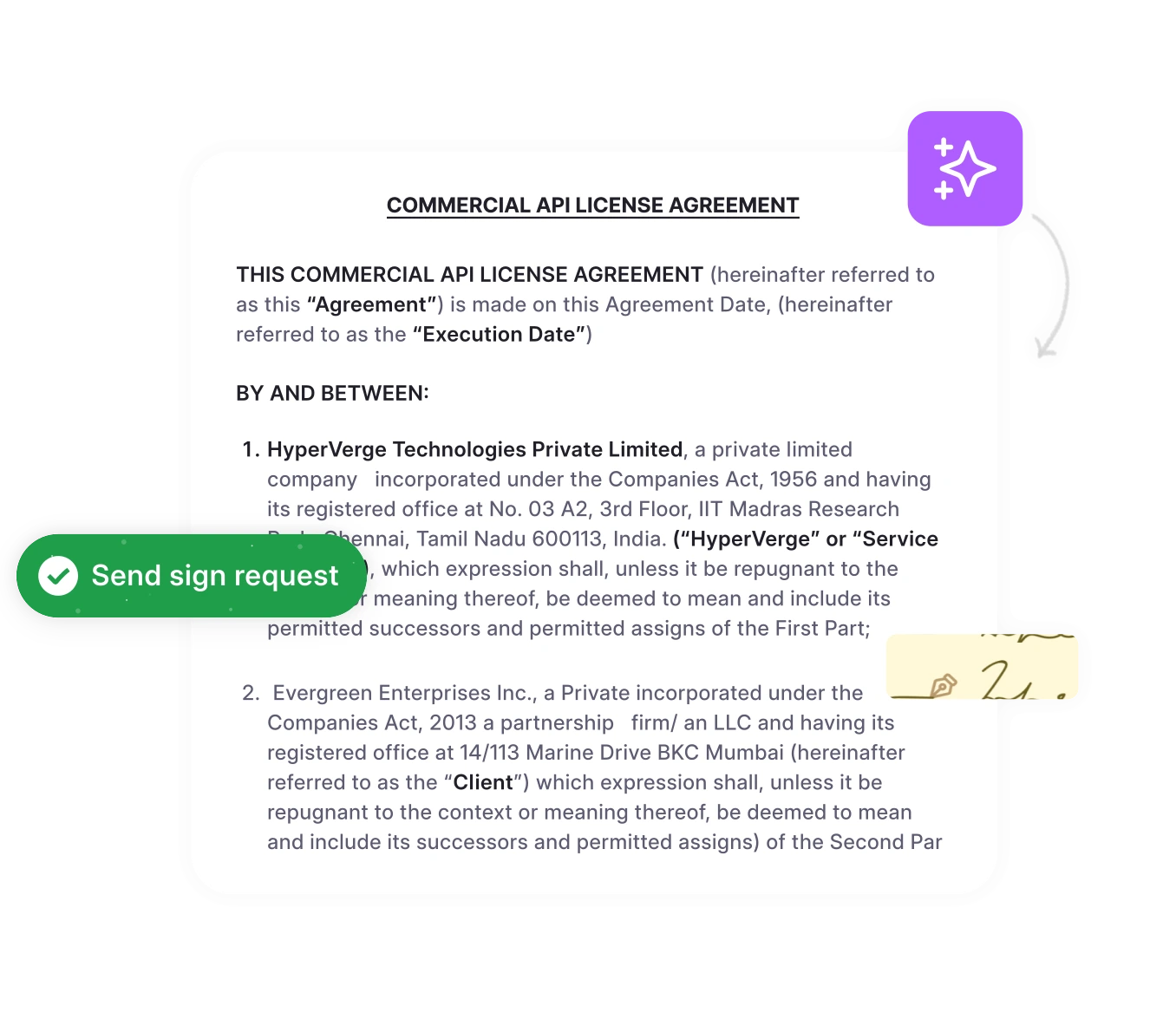Contract management in telecommunications is more complex than in most industries. Telecom providers operate in heavily regulated environments while managing diverse agreements spanning network infrastructure, vendor relationships, regulatory compliance, and customer services.
Poor contract management creates significant risks: missed renewals, billing disputes, compliance issues, and revenue leakage. Without proper oversight, organizations struggle to track critical obligations, monitor vendor performance, and optimize contract terms across their portfolios.
This guide covers the essential aspects of telecom contract management, from understanding common challenges to implementing contract lifecycle management solutions that streamline operations and reduce risks.
What is telecom contract management?
The term telecom contract management refers to the process of managing the overall lifecycle of telecommunications agreements. It starts from the initial negotiation and goes on to contract expiration or renewal.
Telecom contract management comprises handling different types of agreements, like those for customers, network systems, and suppliers. Doing this well helps a company follow the rules of the contracts, avoid risks, save money, and maximize the benefits of each agreement.
It also means regularly checking and improving these contracts to make sure the company is getting good service, spending wisely, and working well with vendors.
That telecommunications contracting complexity is significant, with 41% of buy-side transactions and 43% of sell-side agreements falling into the high-complexity category. An additional 38% and 36% respectively are classified as medium-complexity, underscoring the intricate nature of telecom contract management.
Telcom contract management comprises three fundamental components:
Performance monitoring and compliance
Strategic optimization and renewal
Each component requires specialized knowledge of telecommunications regulations, technical specifications, and industry standards that govern everything from spectrum allocation to interconnection agreements.
With an understanding of contract management in place, it’s time to delve into the main types of telecom contracts.
What are the different types of telecom contracts?
Telecommunications providers manage a diverse portfolio of contracts that support every aspect of their operations.
Advanced CLM practices, with 34% of organizations utilizing standard terms databases and 15% incorporating pre-approved fallback term options. This compares favorably with cross-sector averages of 20% and 8% respectively, indicating the industry’s commitment to combining knowledge, skills, and technology to reduce friction and improve performance.
Understanding these contract types and their specific requirements is essential for effective management and optimization.
| Contract Type | Purpose | Key Stakeholders | Main Challenges |
| Tower Lease Agreements | Secure cell site placement and infrastructure access | Tower companies, property owners, zoning authorities | Rent escalation, modification rights, technology upgrade clauses |
| Equipment Procurement | Network hardware acquisition (switches, routers, base stations) | OEMs (Ericsson, Nokia, Huawei), technical teams | Technical obsolescence, warranty terms, support obligations |
| Interconnection Agreements | Enable traffic exchange between carrier networks | Other carriers, network operators, regulatory bodies | Pricing disputes, traffic routing, quality standards |
| Spectrum Licensing | Legal right to use specific radio frequencies | Government agencies (FCC), regulatory bodies | Compliance requirements, usage restrictions, renewal terms |
| Enterprise Service Contracts | Business-to-business telecommunications services | Corporate customers, account managers, support teams | SLA performance, pricing changes, service modifications |
| Wholesale Agreements | Bulk capacity sales to other service providers | MVNOs, resellers, other carriers | Volume commitments, pricing tiers, quality guarantees |
| Roaming Partnerships | Customer access to services outside home network | International carriers, roaming hubs | Inter-operator rates, billing reconciliation, fraud management |
| Fiber Infrastructure | Dark fiber, lit services, and network construction | Infrastructure providers, construction companies | Right-of-way access, construction delays, maintenance obligations |
| Software Licensing | Network management and operational software | Software vendors, IT teams, operations | Usage rights, integration requirements, support terms |
| Maintenance & Support | Ongoing equipment and network support services | Service providers, equipment manufacturers | Response times, parts availability, escalation procedures |
| Regulatory Compliance | Government mandated services and obligations | Regulatory bodies, compliance teams | Changing regulations, reporting requirements, penalties |
| Cloud & Data Center | Hosting, colocation, and cloud infrastructure services | Cloud providers, data center operators | Service availability, data security, migration complexity |
Flag legal risk in SLAs and multi-vendor contracts
From unrealistic uptime commitments to hidden termination triggers, HyperStart highlights red flags in telecom agreements instantly.
Book a DemoHaving detailed the various types of telecom contracts, it is essential to understand the lifecycle process that each contract undergoes from initiation to completion.
Contract lifecycle management process in telecom industry
The telecom contract lifecycle is a vital framework that ensures contracts are managed effectively and aligned with business needs in the telecommunications industry.
33% of telecommunications organizations identify developing and implementing a digital contracting strategy as a priority, reflecting the sector’s focus on process improvement.
Here are the 4 essential steps of telecom contract lifecycle process as listed below:
1. Sourcing and vendor evaluation
At first, the providers assess potential partners based on technical capabilities, financial stability, and regulatory compliance. This phase requires deep industry knowledge to evaluate factors like network reliability, spectrum efficiency, and service quality metrics.
2. Negotiation and execution
The next step involves intricate discussions around pricing models, service level agreements, technical specifications, and regulatory compliance requirements. Telecom contracts often include unique clauses related to network performance, data security, emergency services, and interconnection standards that require specialized expertise.
3. Ongoing management
It focuses on performance monitoring, compliance tracking, billing reconciliation, and relationship management. This phase is critical in telecommunications because service disruptions or compliance failures can have immediate impacts on customer service and regulatory standing.
In some cases, poor management of your telecommunications contracts could be costing you between 10 – 20% of your monthly bill, in addition the distraction and disruption to your staff that are having to administer the vendors whilst doing their day job.
4. Renewal or termination
This involves analyzing performance, assessing current market conditions, and evaluating alternatives. Establish clear procedures for contract termination, including notice periods and asset transfer. Develop a structured process for resolving disputes that may arise during this stage, escalating issues when necessary, and seeking legal counsel when appropriate.
Now that we understand the telecom contract lifecycle process, let’s turn our focus to the most common hurdles encountered in managing these contracts.
What are the most common challenges of telecom contract management?
Telecommunications providers face a complex web of contract management challenges that stem from the industry’s unique characteristics: heavy regulation, rapid technological change, and the critical nature of communication services in modern society.
Here are the 5 common challenges of telecom contract management as listed below.
1. Regulatory compliance and risk management
The telecommunications industry operates under extensive regulatory oversight that creates significant compliance challenges. Federal regulations cover emergency services access, customer privacy, network security, and service quality standards.
57% of telcos are concerned about evolving security threats, including AI-powered cyberattacks and infrastructure risks. They emphasize the importance of trust, privacy, and transparent use of AI in contract and service management.
State and local regulations add complexity, with different jurisdictions imposing varying requirements for service delivery and infrastructure deployment. International regulations become critical for providers offering global services.
2. Managing high volume and contract complexity
With complexity ratings showing that over 40% of telecom contracts fall into high-complexity categories, telecommunications providers typically manage thousands of contracts simultaneously. The volume, coupled with complexity, creates significant logistical challenges.
High-volume customer contracts require standardized processes and automated management systems to track renewals and service modifications. Complex infrastructure agreements involve multiple stakeholders and performance metrics requiring specialized monitoring.
3. Technology evolution and contract adaptability
5G deployment requires new types of agreements covering network slicing and edge computing that traditional contracts may not adequately address. IoT expansion introduces contract models based on device connectivity and data usage patterns that differ from traditional services.
Cloud services integration requires contracts addressing data security, service availability, and performance standards for hybrid cloud-telecommunications offerings.
4. Billing discrepancies and financial disputes
Complex pricing structures, usage-based billing, and interconnection settlements create numerous opportunities for billing errors and disagreements. Interconnection billing involves complex calculations for traffic exchange between carriers, often resulting in disputes over traffic volumes and settlement rates.
5. Vendor relationship and performance management
Service level agreement monitoring requires continuous tracking of network performance, service availability, and response times across multiple vendors. Vendor consolidation pressures create challenges in maintaining competitive pricing while ensuring service quality and redundancy.
Bring legal consistency to complex telecom agreements
Whether you’re managing vendor onboarding, tower leasing, or interconnect agreements, HyperStart flags deviations from your standards in seconds.
Book a DemoAfter reviewing the typical challenges in telecom contract management, it is important to focus on best practices that drive success and streamline contract processes.
What are the best practices for successful telecom contract management?
Successful telecom contract management requires a strategic approach that addresses organizational readiness, technology selection, and ongoing optimization to ensure efficiency, compliance, and business value.
Here are 5 key best practices for effective telecom contract management:
1. Strategic planning and organizational readiness
Stakeholder alignment across legal, procurement, operations, and technical teams ensures contract management initiatives support broader business objectives. Process standardization provides the foundation for efficient contract management by establishing consistent approaches.
Governance framework development establishes clear roles, responsibilities, and decision-making authorities for contract management activities.
2. Technology selection and platform evaluation
Industry-specific functionality should be the primary consideration when evaluating CLM platforms. Telecom contract management solution must address regulatory requirements, technical specifications, and integration needs specific to telecommunications operations.
Given that telecommunications organizations demonstrate above-average adoption of standard terms databases (34% versus 20% cross-sector), scalability requirements must reflect the high-volume nature of telecommunications contracting.
3. Implementation strategy and change management
Phased rollout approaches reduce implementation risk by starting with high-impact contract types and gradually expanding. Pilot program design enables organizations to test CLM capabilities and refine processes before full-scale deployment.
Change management initiatives address the organizational impact of new contract management processes and technology.
4. Training and user adoption
Role-based training programs address the diverse user community involved in telecommunications contract management. Continuous learning initiatives support ongoing capability development as processes mature.
User feedback processes enable continuous improvement of contract management capabilities based on user experience and business requirements.
5. Ongoing optimization and performance measurement
Key performance indicator tracking enables measurement of contract management effectiveness through metrics like contract cycle time, compliance rates, and cost savings. Process improvement initiatives leverage performance data to identify optimization opportunities.
Technology upgrade planning addresses the ongoing need to enhance CLM capabilities and integrate new features that support business objectives.
Now that we’ve examined best practices, let’s explore how contract lifecycle management drives operational improvements and strategic value in telecom organizations.
How does contract lifecycle management transform telecom operations?
Many telecommunications providers struggle with contract management because it’s often fragmented across multiple systems and departments. Contract Lifecycle Management (CLM) addresses this by integrating the entire contract process, allowing teams to manage creation, execution, and monitoring in one centralized platform.
Here are 4 ways in which CLM is transforming the management of telecom contracts:
1. Automated contract creation and approval workflows
Template libraries enable standardized contract language while ensuring compliance with telecom regulations. Pre-approved templates for tower leases, interconnection agreements, and service contracts accelerate the contracting process. AI-powered redlining provides first-cut reviews within one minute, significantly reducing legal review time.
2. Real-time obligation tracking and compliance monitoring
CLM platforms automatically extract key dates, milestones, and obligations from telecom contracts, creating tracking mechanisms that ensure nothing falls through the cracks. Automated alerts notify stakeholders of potential issues before they become contractual violations or service disruptions.
3. Performance analytics and spend optimization
Contract performance dashboards provide real-time visibility into portfolios, enabling providers to identify trends, risks, and optimization opportunities. This capability is essential for addressing the 10-20% of monthly billing costs potentially lost to poor contract management. Spend analysis helps identify cost reduction opportunities, vendor consolidation possibilities, and pricing optimization strategies.
4. Seamless integration with telecom business systems
ERP and financial system integration ensures contract data flows into financial planning and reporting processes. CRM integration enables sales teams to identify upselling opportunities, while network management integration correlates vendor performance with service quality.
Eliminate blind spots in high-volume contract reviews
HyperStart helps telecom legal teams identify risks in service-level guarantees, pricing models, and renewal clauses—at scale.
Book a Demo










